engine overheat TOYOTA VENZA 2009 Owners Manual (in English)
[x] Cancel search | Manufacturer: TOYOTA, Model Year: 2009, Model line: VENZA, Model: TOYOTA VENZA 2009Pages: 620, PDF Size: 11.43 MB
Page 5 of 620
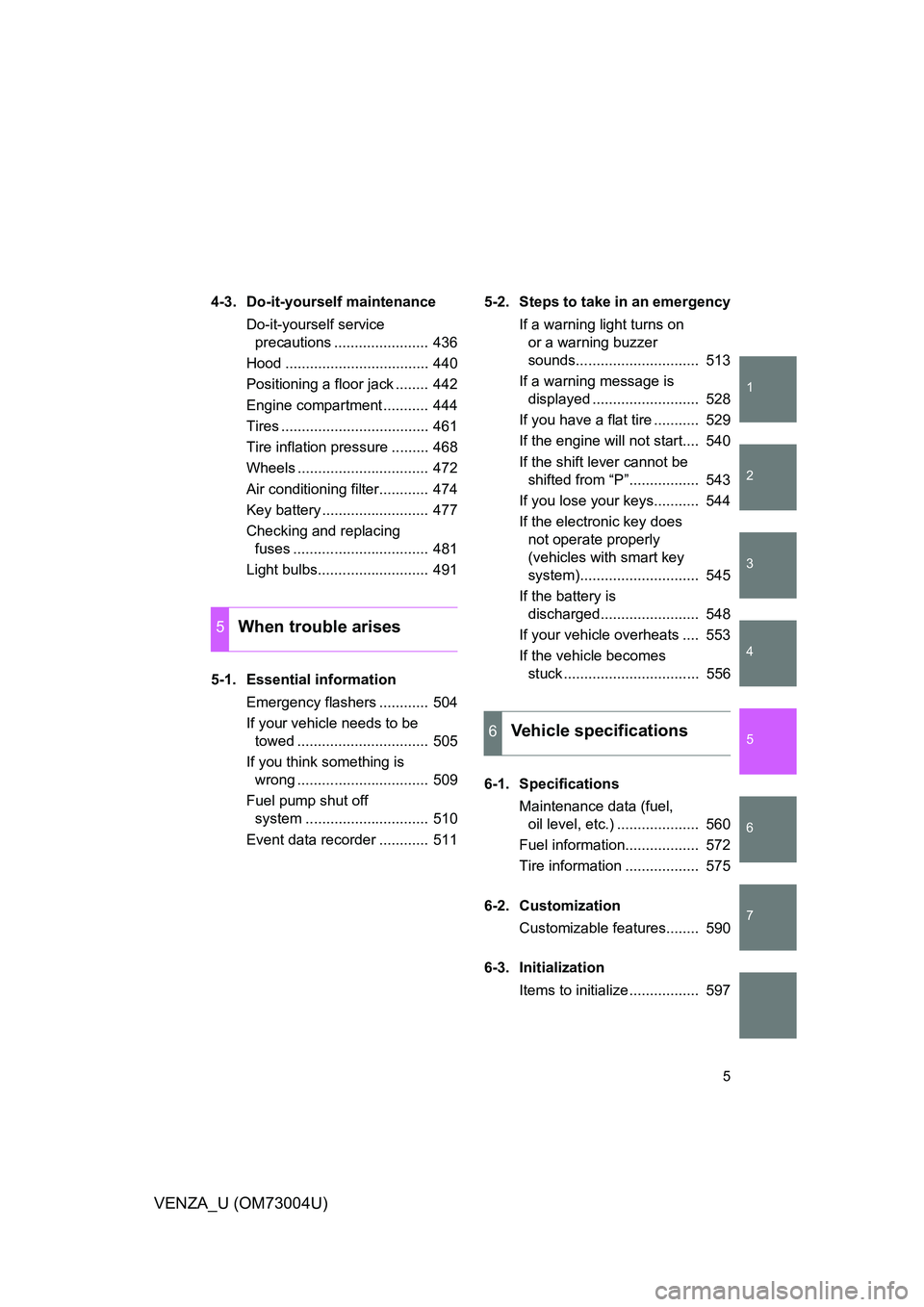
1
2
3
4
5
6
7
5
VENZA_U (OM73004U)
4-3. Do-it-yourself maintenanceDo-it-yourself service precautions ....................... 436
Hood ................................... 440
Positioning a floor jack ........ 442
Engine compartment ........... 444
Tires .................................... 461
Tire inflation pressure ......... 468
Wheels ................................ 472
Air conditioning filter............ 474
Key battery .......................... 477
Checking and replacing fuses ................................. 481
Light bulbs........................... 491
5-1. Essential information Emergency flashers ............ 504
If your vehicle needs to be towed ................................ 505
If you think something is wrong ................................ 509
Fuel pump shut off system .............................. 510
Event data recorder ............ 511 5-2. Steps to take in an emergency
If a warning light turns on or a warning buzzer
sounds.............................. 513
If a warning message is displayed .......................... 528
If you have a flat tire ........... 529
If the engine will not start.... 540
If the shift lever cannot be shifted from “P”................. 543
If you lose your keys........... 544
If the electronic key does not operate properly
(vehicles with smart key
system)............................. 545
If the battery is discharged........................ 548
If your vehicle overheats .... 553
If the vehicle becomes stuck ................................. 556
6-1. Specifications Maintenance data (fuel, oil level, etc.) .................... 560
Fuel information.................. 572
Tire information .................. 575
6-2. Customization Customizable features........ 590
6-3. Initialization Items to initialize ................. 597
5When trouble arises
6Vehicle specifications
Page 156 of 620
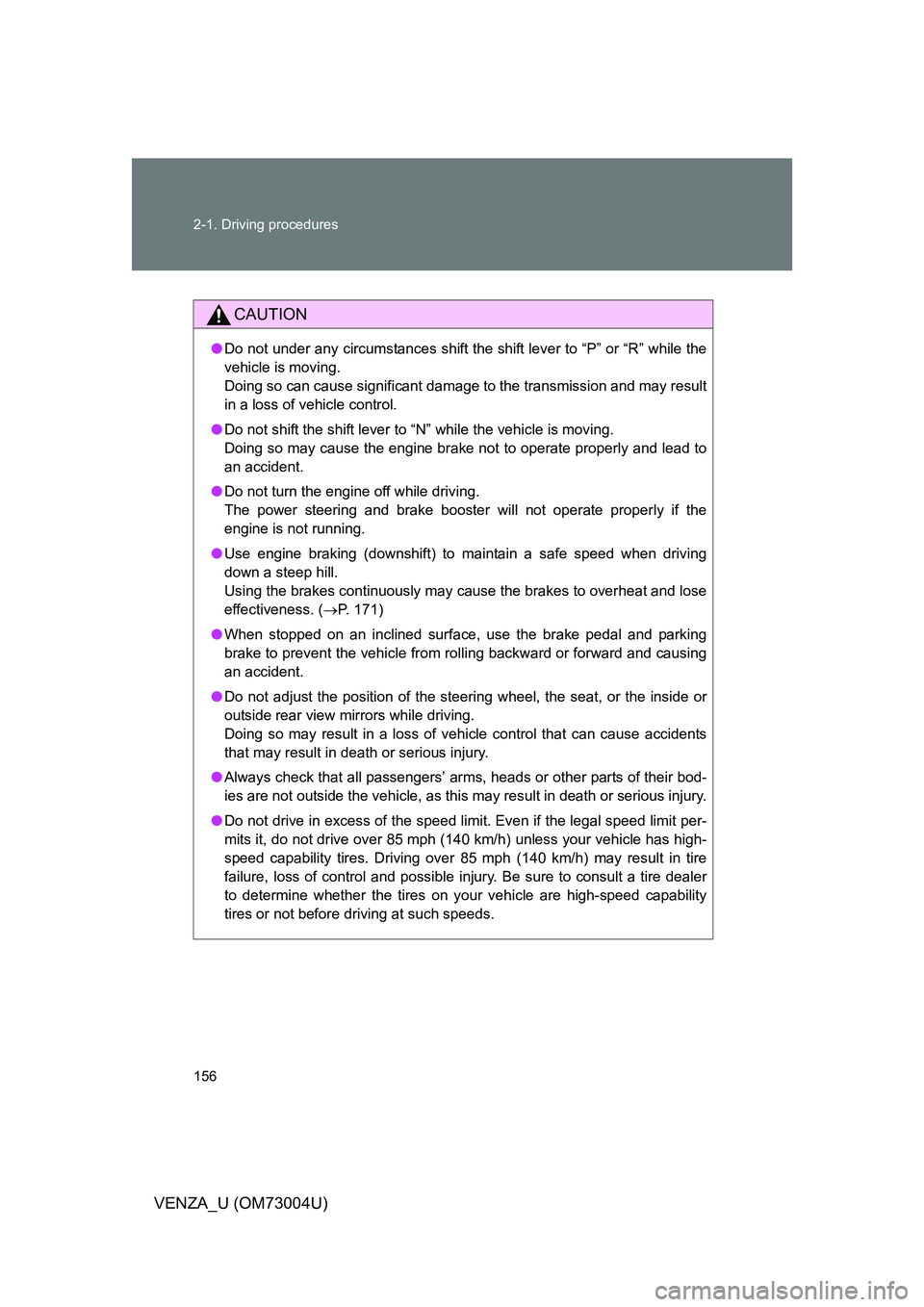
156 2-1. Driving procedures
VENZA_U (OM73004U)
CAUTION
●Do not under any circumstances shift the shift lever to “P” or “R” while the
vehicle is moving.
Doing so can cause significant damage to the transmission and may result
in a loss of vehicle control.
● Do not shift the shift lever to “N” while the vehicle is moving.
Doing so may cause the engine brake not to operate properly and lead to
an accident.
● Do not turn the engine off while driving.
The power steering and brake booster will not operate properly if the
engine is not running.
● Use engine braking (downshift) to maintain a safe speed when driving
down a steep hill.
Using the brakes continuously may cause the brakes to overheat and lose
effectiveness. ( P. 171)
● When stopped on an inclined surface, use the brake pedal and parking
brake to prevent the vehicle from rolling backward or forward and causing
an accident.
● Do not adjust the position of the steering wheel, the seat, or the inside or
outside rear view mirrors while driving.
Doing so may result in a loss of vehicle control that can cause accidents
that may result in death or serious injury.
● Always check that all passengers’ arms, heads or other parts of their bod-
ies are not outside the vehicle, as this may result in death or serious injury.
● Do not drive in excess of the speed limit. Even if the legal speed limit per-
mits it, do not drive over 85 mph (140 km/h) unless your vehicle has high-
speed capability tires. Driving over 85 mph (140 km/h) may result in tire
failure, loss of control and possible injury. Be sure to consult a tire dealer
to determine whether the tires on your vehicle are high-speed capability
tires or not before driving at such speeds.
Page 159 of 620
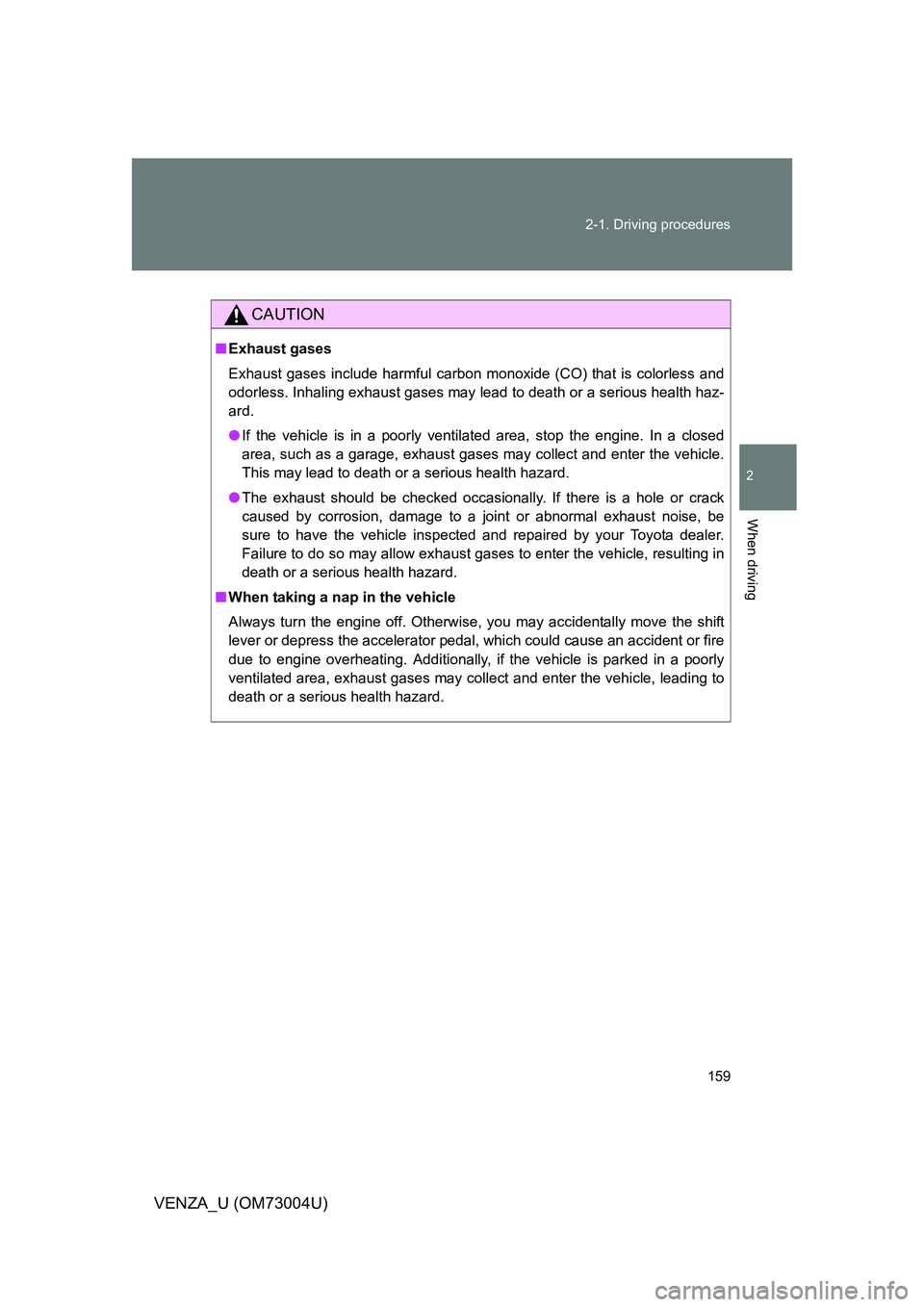
159
2-1. Driving procedures
2
When driving
VENZA_U (OM73004U)
CAUTION
■
Exhaust gases
Exhaust gases include harmful carbon monoxide (CO) that is colorless and
odorless. Inhaling exhaust gases may lead to death or a serious health haz-
ard.
● If the vehicle is in a poorly ventilated area, stop the engine. In a closed
area, such as a garage, exhaust gases may collect and enter the vehicle.
This may lead to death or a serious health hazard.
● The exhaust should be checked occasionally. If there is a hole or crack
caused by corrosion, damage to a joint or abnormal exhaust noise, be
sure to have the vehicle inspected and repaired by your Toyota dealer.
Failure to do so may allow exhaust gases to enter the vehicle, resulting in
death or a serious health hazard.
■ When taking a nap in the vehicle
Always turn the engine off. Otherwise, you may accidentally move the shift
lever or depress the accelerator pedal, which could cause an accident or fire
due to engine overheating. Additionally, if the vehicle is parked in a poorly
ventilated area, exhaust gases may collect and enter the vehicle, leadin\
g to
death or a serious health hazard.
Page 169 of 620
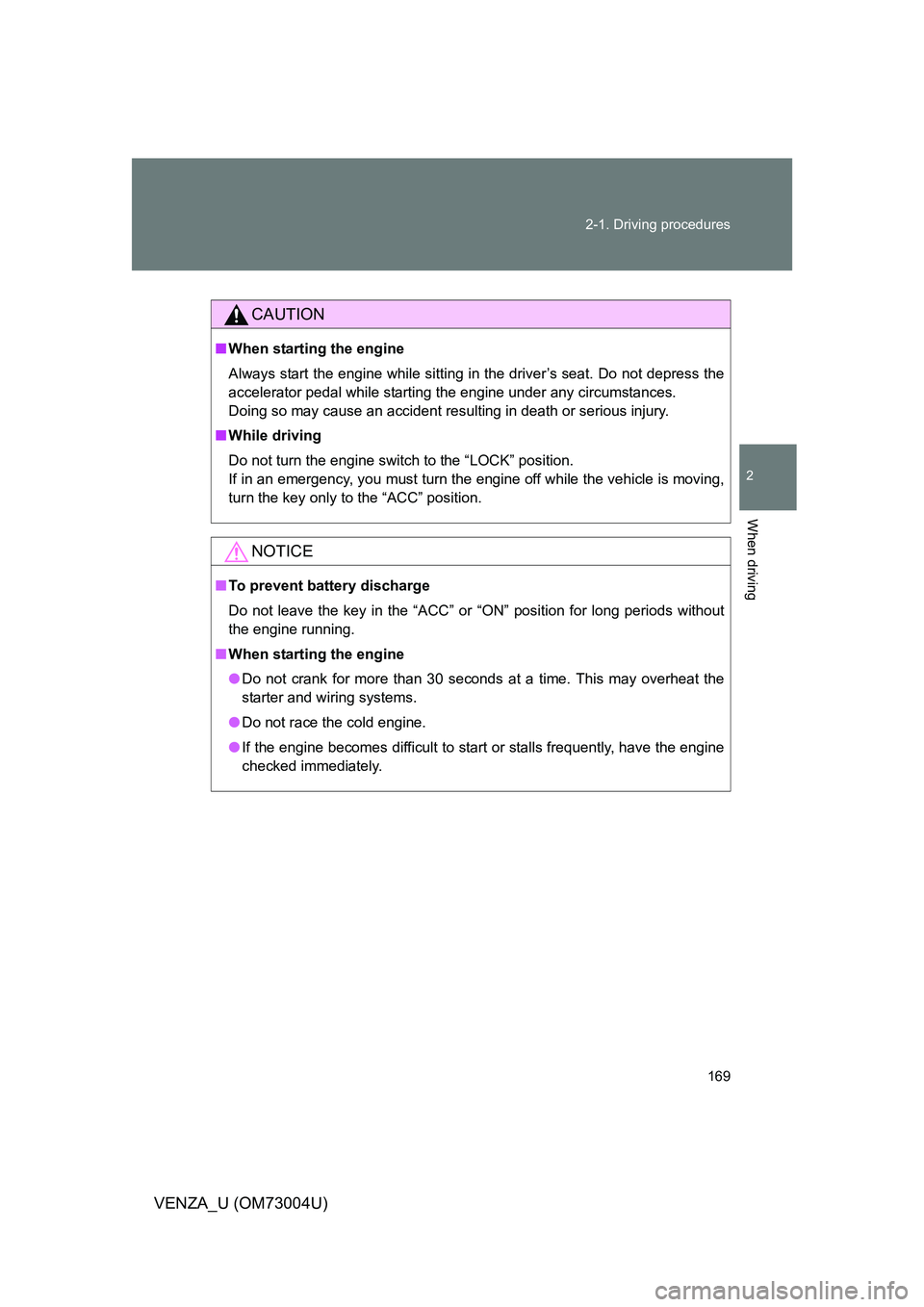
169
2-1. Driving procedures
2
When driving
VENZA_U (OM73004U)
CAUTION
■
When starting the engine
Always start the engine while sitting in the driver’s seat. Do not depress the
accelerator pedal while starting the engine under any circumstances.
Doing so may cause an accident resulting in death or serious injury.
■ While driving
Do not turn the engine switch to the “LOCK” position.
If in an emergency, you must turn the engine off while the vehicle is moving,
turn the key only to the “ACC” position.
NOTICE
■To prevent battery discharge
Do not leave the key in the “ACC” or “ON” position for long periods without
the engine running.
■ When starting the engine
● Do not crank for more than 30 seconds at a time. This may overheat the
starter and wiring systems.
● Do not race the cold engine.
● If the engine becomes difficult to start or stalls frequently, have the engine
checked immediately.
Page 174 of 620
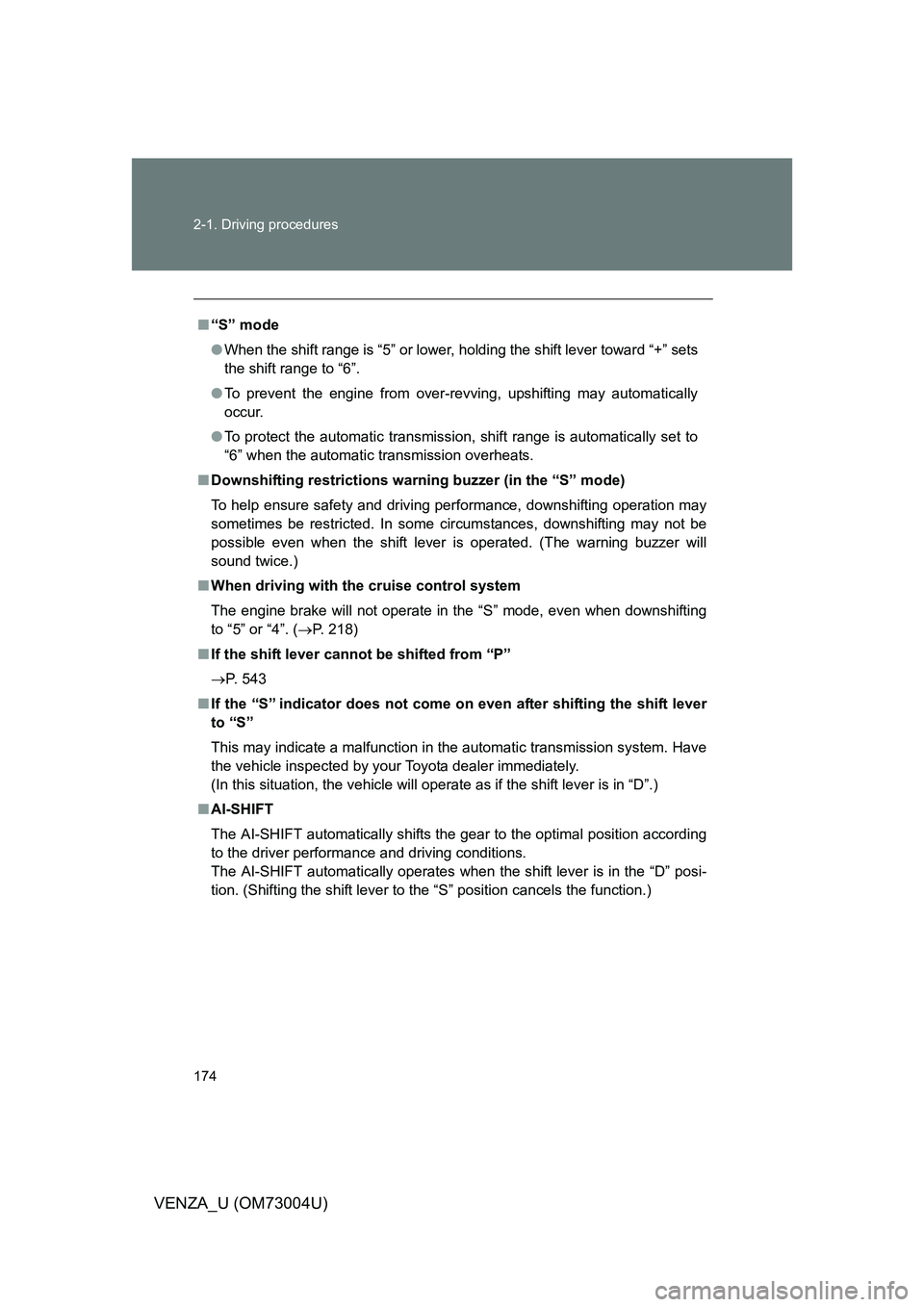
174 2-1. Driving procedures
VENZA_U (OM73004U)
■“S” mode
● When the shift range is “5” or lower, holding the shift lever toward “+” sets
the shift range to “6”.
● To prevent the engine from over-revving, upshifting may automatically
occur.
● To protect the automatic transmission, shift range is automatically set to
“6” when the automatic transmission overheats.
■ Downshifting restrictions warning buzzer (in the “S” mode)
To help ensure safety and driving performance, downshifting operation may
sometimes be restricted. In some circumstances, downshifting may not be
possible even when the shift lever is operated. (The warning buzzer will
sound twice.)
■ When driving with the cruise control system
The engine brake will not operate in t he “S” mode, even when downshifting
to “5” or “4”. ( P. 218)
■ If the shift lever cannot be shifted from “P”
P. 543
■ If the “S” indicator does not come on even after shifting the shift lever
to “S”
This may indicate a malfunction in the automatic transmission system. Have
the vehicle inspected by your Toyota dealer immediately.
(In this situation, the vehicle will operate as if the shift lever is in “D”.)
■ AI-SHIFT
The AI-SHIFT automatically shifts the gear to the optimal position according
to the driver performance and driving conditions.
The AI-SHIFT automatically operates when the shift lever is in the “D” posi-
tion. (Shifting the shift lever to the “S” position cancels the function.)
Page 180 of 620
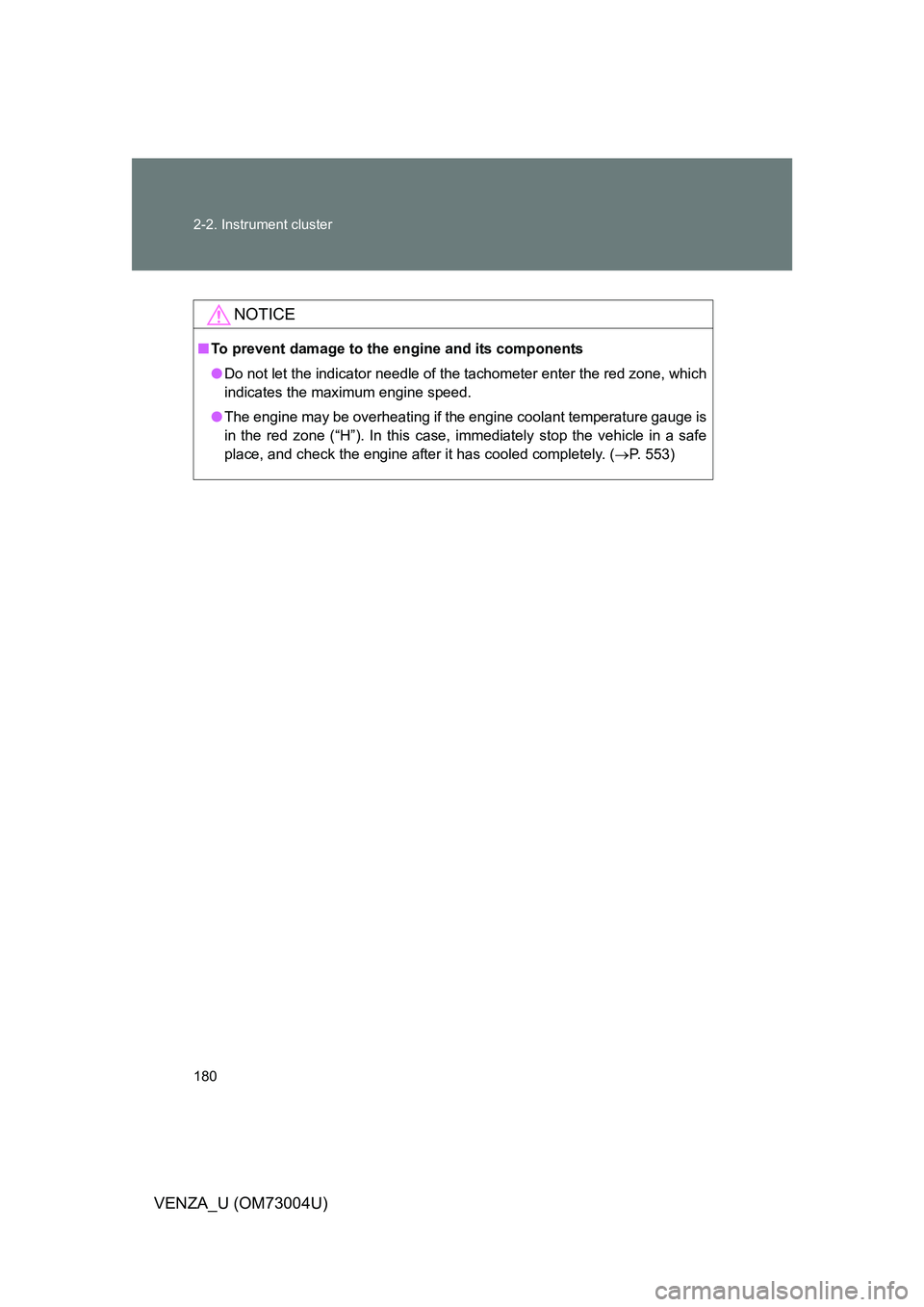
180 2-2. Instrument cluster
VENZA_U (OM73004U)
NOTICE
■To prevent damage to the engine and its components
● Do not let the indicator needle of the tachometer enter the red zone, which
indicates the maximum engine speed.
● The engine may be overheating if the engine coolant temperature gauge is
in the red zone (“H”). In this case, immediately stop the vehicle in a safe
place, and check the engine after it has cooled completely. ( P. 553)
Page 231 of 620
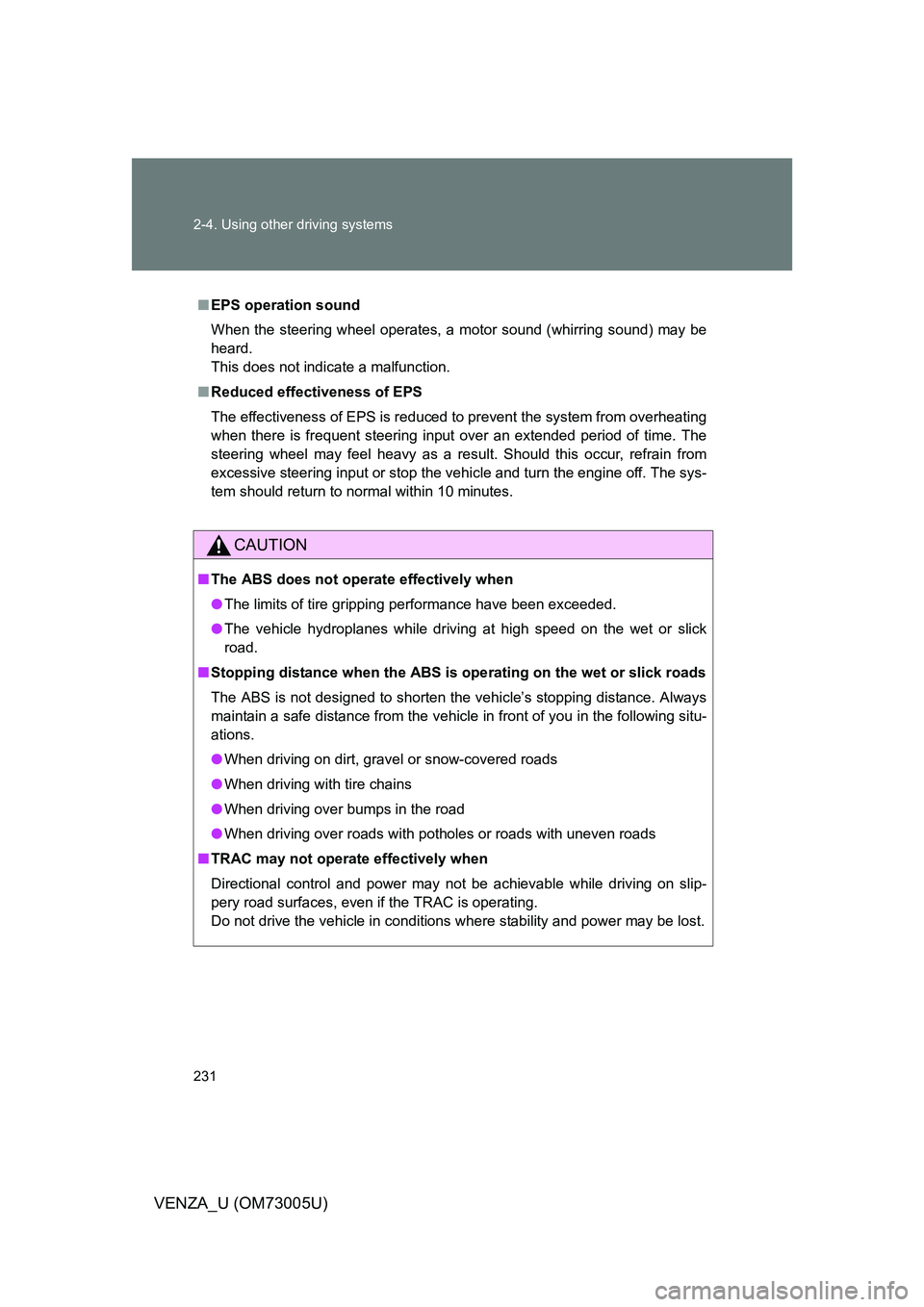
231 2-4. Using other driving systems
VENZA_U (OM73005U)
■EPS operation sound
When the steering wheel operates, a motor sound (whirring sound) may be
heard.
This does not indicate a malfunction.
■ Reduced effectiveness of EPS
The effectiveness of EPS is reduced to prevent the system from overheating
when there is frequent steering input over an extended period of time. The
steering wheel may feel heavy as a result. Should this occur, refrain from
excessive steering input or stop the vehicle and turn the engine off. The sys-
tem should return to normal within 10 minutes.
CAUTION
■The ABS does not operate effectively when
● The limits of tire gripping performance have been exceeded.
● The vehicle hydroplanes while driving at high speed on the wet or slick
road.
■ Stopping distance when the ABS is ope rating on the wet or slick roads
The ABS is not designed to shorten the vehicle’s stopping distance. Always
maintain a safe distance from the vehicle in front of you in the following situ-
ations.
● When driving on dirt, gravel or snow-covered roads
● When driving with tire chains
● When driving over bumps in the road
● When driving over roads with pothol es or roads with uneven roads
■ TRAC may not operate effectively when
Directional control and power may not be achievable while driving on slip-
pery road surfaces, even if the TRAC is operating.
Do not drive the vehicle in conditions where stability and power may be lost.
Page 256 of 620
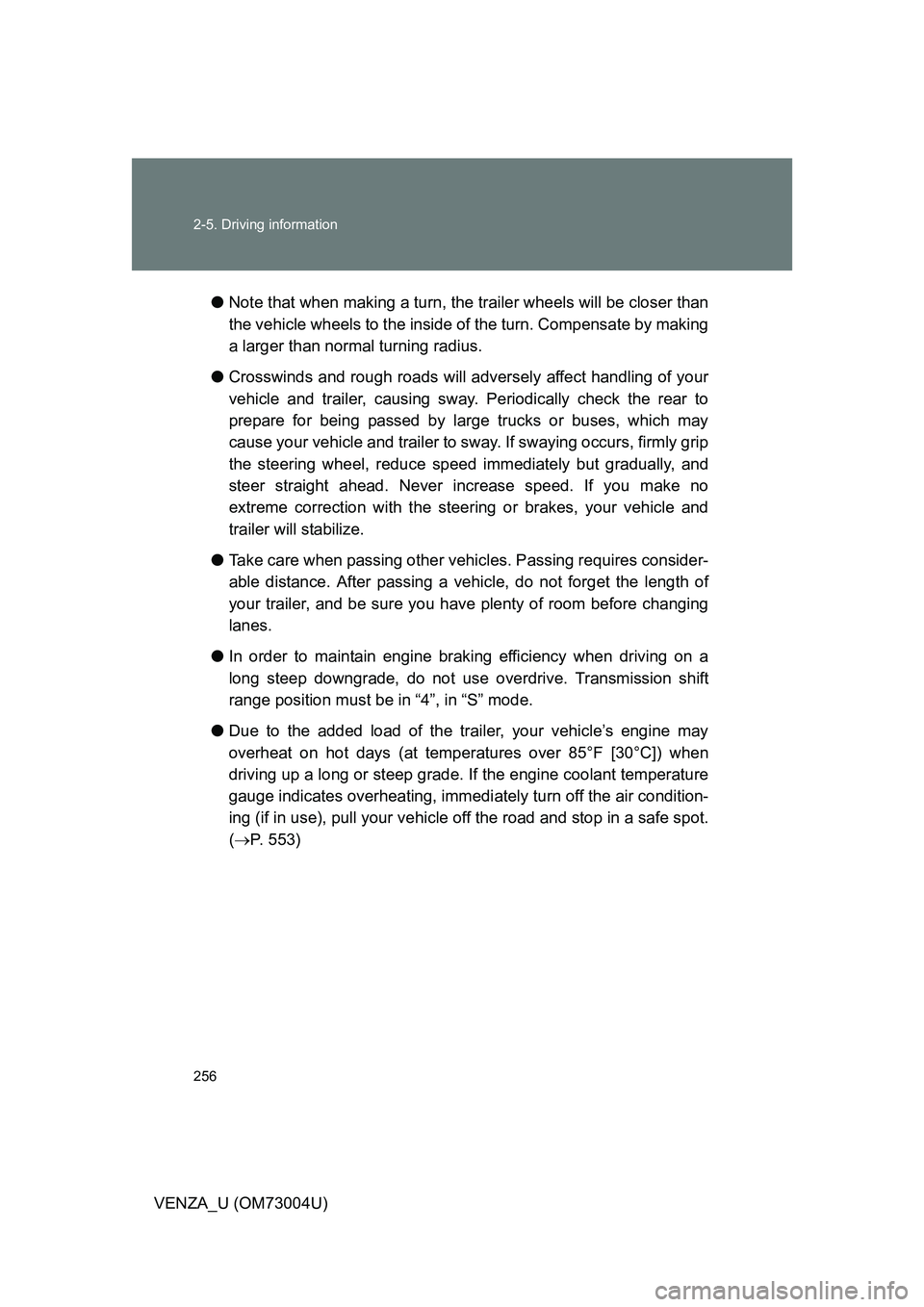
256 2-5. Driving information
VENZA_U (OM73004U)●
Note that when making a turn, th e trailer wheels will be closer than
the vehicle wheels to the inside of the turn. Compensate by making
a larger than normal turning radius.
● Crosswinds and rough roads will adversely affect handling of your
vehicle and trailer, causing sway . Periodically check the rear to
prepare for being passed by large trucks or buses, which may
cause your vehicle and trailer to sway. If swaying occurs, firmly grip
the steering wheel, reduce speed immediately but gradually, and
steer straight ahead. Never increase speed. If you make no
extreme correction with the stee ring or brakes, your vehicle and
trailer will stabilize.
● Take care when passing other v ehicles. Passing requires consider-
able distance. After passing a vehi cle, do not forget the length of
your trailer, and be sure you hav e plenty of room before changing
lanes.
● In order to maintain engine braking efficiency when driving on a
long steep downgrade, do not use overdrive. Transmission shift
range position must be in “4”, in “S” mode.
● Due to the added load of the trailer, your vehicle’s engine may
overheat on hot days (at temper atures over 85°F [30°C]) when
driving up a long or steep grade. If the engine coolant temperature
gauge indicates overheating, immediately turn off the air condition-
ing (if in use), pull your vehicle off the road and stop in a safe spot.
( P. 553)
Page 406 of 620
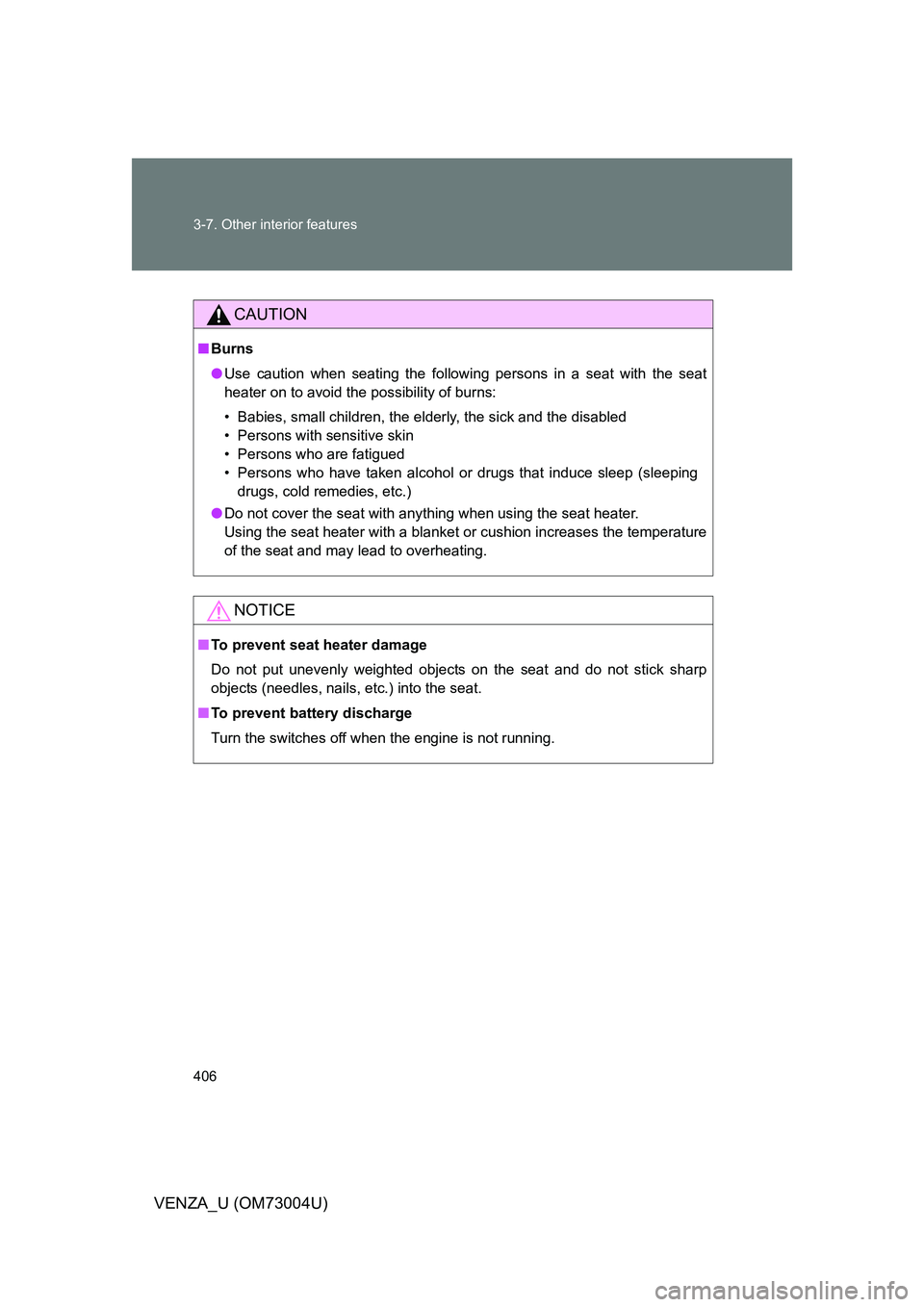
406 3-7. Other interior features
VENZA_U (OM73004U)
CAUTION
■Burns
● Use caution when seating the following persons in a seat with the seat
heater on to avoid the possibility of burns:
• Babies, small children, the elderly, the sick and the disabled
• Persons with sensitive skin
• Persons who are fatigued
• Persons who have taken alcohol or drugs that induce sleep (sleeping
drugs, cold remedies, etc.)
● Do not cover the seat with anything when using the seat heater.
Using the seat heater with a blanket or cushion increases the temperature
of the seat and may lead to overheating.
NOTICE
■To prevent seat heater damage
Do not put unevenly weighted objects on the seat and do not stick sharp
objects (needles, nails, etc.) into the seat.
■ To prevent battery discharge
Turn the switches off when the engine is not running.
Page 503 of 620
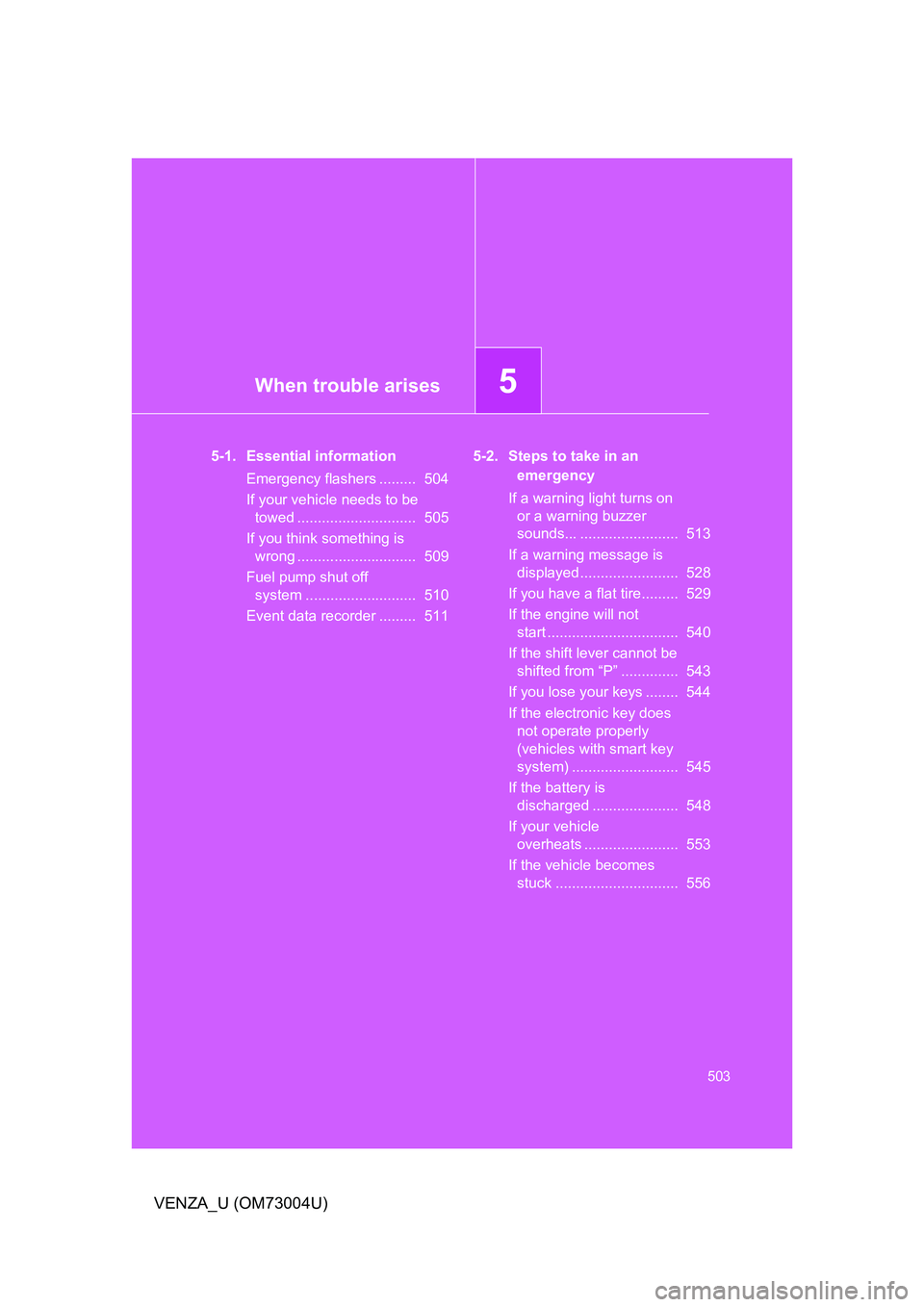
When trouble arises5
503
VENZA_U (OM73004U)
5-1. Essential informationEmergency flashers ......... 504
If your vehicle needs to be towed ............................. 505
If you think something is wrong ............................. 509
Fuel pump shut off system ........................... 510
Event data recorder ......... 511 5-2. Steps to take in an
emergency
If a warning light turns on or a warning buzzer
sounds... ........................ 513
If a warning message is displayed ........................ 528
If you have a flat tire......... 529
If the engine will not start ................................ 540
If the shift lever cannot be shifted from “P” .............. 543
If you lose your keys ........ 544
If the electronic key does not operate properly
(vehicles with smart key
system) .......................... 545
If the battery is discharged ..................... 548
If your vehicle overheats ....................... 553
If the vehicle becomes stuck .............................. 556